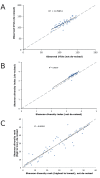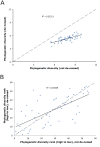Implications of pyrosequencing error correction for biological data interpretation
- PMID: 22952965
- PMCID: PMC3431371
- DOI: 10.1371/journal.pone.0044357
Implications of pyrosequencing error correction for biological data interpretation
Abstract
There has been a rapid proliferation of approaches for processing and manipulating second generation DNA sequence data. However, users are often left with uncertainties about how the choice of processing methods may impact biological interpretation of data. In this report, we probe differences in output between two different processing pipelines: a de-noising approach using the AmpliconNoise algorithm for error correction, and a standard approach using quality filtering and preclustering to reduce error. There was a large overlap in reads culled by each method, although AmpliconNoise removed a greater net number of reads. Most OTUs produced by one method had a clearly corresponding partner in the other. Although each method resulted in OTUs consisting entirely of reads that were culled by the other method, there were many more such OTUs formed in the standard pipeline. Total OTU richness was reduced by AmpliconNoise processing, but per-sample OTU richness, diversity and evenness were increased. Increases in per-sample richness and diversity may be a result of AmpliconNoise processing producing a more even OTU rank-abundance distribution. Because communities were randomly subsampled to equalize sample size across communities, and because rare sequence variants are less likely to be selected during subsampling, fewer OTUs were lost from individual communities when subsampling AmpliconNoise-processed data. In contrast to taxon-based diversity estimates, phylogenetic diversity was reduced even on a per-sample basis by de-noising, and samples switched widely in diversity rankings. This work illustrates the significant impacts of processing pipelines on the biological interpretations that can be made from pyrosequencing surveys. This study provides important cautions for analyses of contemporary data, for requisite data archiving (processed vs. non-processed data), and for drawing comparisons among studies performed using distinct data processing pipelines.
Conflict of interest statement
Figures




References
-
- Quince C, Lanzén A, Curtis TP, Davenport RJ, Hall N, et al. (2009) Accurate determination of microbial diversity from 454 pyrosequencing data. Nat Meth 6: 639–641 doi:10.1038/nmeth.1361. - DOI - PubMed
-
- Kunin V, Engelbrektson A, Ochman H, Hugenholtz P (2010) Wrinkles in the rare biosphere: Pyrosequencing errors can lead to artificial inflation of diversity estimates. Environ Microbiol 12: 118–123 doi:10.1111/j.1462-2920.2009.02051.x. - DOI - PubMed
-
- Sun Y, Cai Y, Liu L, Yu F, Farrell ML, et al. (2009) ESPRIT: Estimating species richness using large collections of 16S rRNA pyrosequences. Nuc Acid Res 37: e76–e76 doi:10.1093/nar/gkp285. - DOI - PMC - PubMed
-
- Zaura E, Keijser BJ, Huse SM, Crielaard W (2009) Defining the healthy “core microbiome” of oral microbial communities. BMC Microbiol 9: 259 doi:10.1186/1471-2180-9-259. - DOI - PMC - PubMed
Publication types
MeSH terms
LinkOut - more resources
Full Text Sources

